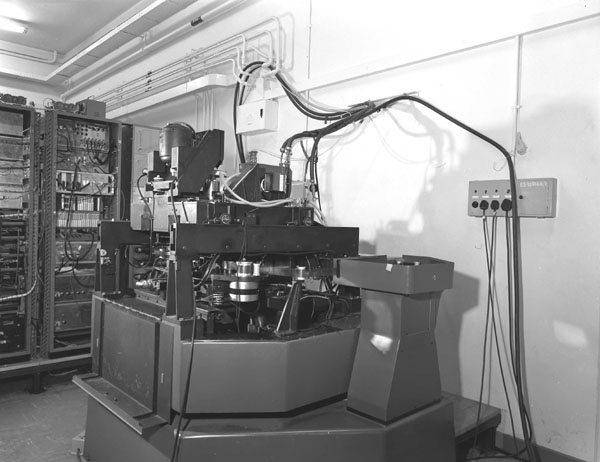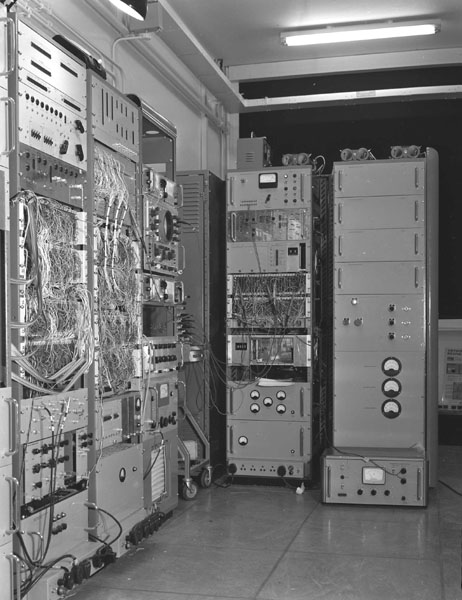

The major responsibilities of the Applied Physics Division are Bubble Chamber operation and development. track analysis measuring machines. computer facilities. the Variable Energy Cyclotron for AERE. Superconducting magnets and the Electrostatic Generator for Oxford University.
During the period of the report the 1.5 metre Hydrogen Chamber returned to the Laboratory from CERN. The Heavy Liquid Chamber operated and started its first experimental run. The Liquid Helium Chamber was in its final stages of commissioning. The Saclay 80 cm Hydrogen Chamber continued operating throughout the period.
The main point of interest in the computing field was the commissioning of the ORION/DDP coupled computer system which was used for on-line experiments. The system was fully time sharing and could accommodate the HPD flying spot digitiser, a CRT flying spot digitizer for spark chamber film, and three counter experiments. Details of the equipment are given below.
Off-line computing was carried out mainly on the CHILTON ATLAS although the Imperial College IBM 7050 and the Glasgow IBM 7044 were also used. The ORION computer would be replaced in late 1966 by an IBM 360/75 for both on-line and batch processing.
The Variable Energy Cyclotron which was designed by Rutherford Laboratory staff for the Atomic Energy Authority operated with an internal beam. Work was proceeding on beam extraction and ion source development.
The Electrostatic Generator at Oxford successfully reached its design specification.
Future projects included the construction of several superconducting coils to study high field production. a design study of a high field Bubble Chamber using superconducting coils, the implementation of the IBM 360/75 computer with on-line facilities and continued development of automatic measuring machines, including the construction of a second HPD flying spot digitizer.
Towards the end of 1966. when the ORION computer would be replaced by an IBM 360/75 computer, on-line users would be attached through the DDP 224.
ORION functioned throughout 1965 with acceptable reliability. Some changes were made to the Fortran operating system which made it easier to use and more economical of magnetic tapes. As the computing load continued to increase, use of ORION was restricted to programs dealing with on-line devices or experiments, other computation being done on the Chilton Atlas.
The largest program in the ORION system was that which controlled and read data from the Hough-Powell Device (HPD) via the direct data link to the DDP-224 computer.


Other programs converted measurements punched on paper tape to a form acceptable by the Benson-Lehner graph plotter, or to magnetic tape for later use.
This computer was installed in May 1965. and later augmented with the addition of 8K of core store, 2 magnetic tape decks, a Calcomp graph-plotter, and a visual display with light pen. A typewriter was situated in the Experimental Area (P3 experiment). On the whole the DDP behaved reliably, although latent hardware faults emerged as users of the system grew more ambitious. It was connected to ORION via a direct data link, to the P3 experiment, the HPD, the CRT scanner, and to a teleprinter set associated with the K6 experiment.
A control program was written which allowed more than one of these users to operate simultaneously, subject to the limitation of total core store requirements. Users wrote their subroutines in machine code (assembly language) but the control program managed most data input/ output, message reception and dispatch, magnetic tape operations, and communication with ORION. The HPD data were sent on to ORION; other users wrote their results to paper tape or magnetic tape for later off-line analysis by ORION or ATLAS. Messages originating at the console or remote typewriters could command programs to enter defined courses of action or to change numerical program parameters. Messages originated by program could go to either typewriter to report on data received.
When the HPD program was not in ORION, or was temporarily suspended, the P3 experiment program in ORION could analyse data received, print the output on the ORION printer, and send summary information as requested, both graphical and literal, to a display tube in the P3 experimental area.
An alternative control program was written for ORION DDP which handled the transmission of all on-line information on behalf of several data-processing programs which could be simultaneously resident in ORION, the DDP acting solely as a data gathering and disseminating device. The ORION user programs could be written in Fortran and tested independently, a great advantage. The great size of the HPD program in relation to ORION core store unfortunately prevented use of this system.
On ATLAS, programs for the reduction and analysis of bubble- chamber data continue to be developed, and programs for processing data obtained via the DDP from the CRT Scanner were written.
Practically all the above computing activity was carried out by teams of programmers, in particular the multi-use DDP program involved a great deal of cooperation on the part of users.